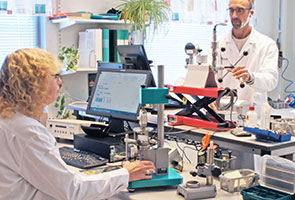There are different type of threads, they can be both external (male) threads (e.g., on a bolt) and internal (female) threads (e.g., in a nut). The external thread is made to fit into the internal thread.
You can find thread in many different everyday items. In your home you’ll find them for example on bottles, tooth paste tubes, bulbs and many more items in your daily life.
The ISO metric screw threads, so called M-threads are symmetrical and V-shaped and are the most common type of threads. Did you know that the ISO metric screw thread system was one of the first standards that was approved by the International Standardization Committee, ISO.
For threads you use a standard (ISO 965) with determined tolerances to see if the thread is approved. That way you will certify that the equipment is fulfilling the requirements.
The most common thread is right threaded, which means that it has a clockwise rotation. The left threaded is most often found where you have a risk that the thread will loose it’s grip, for example for rotating machine parts.
Pitch is the distance from the crest of one thread to the next.
To check threads in different products, thread gauges and thread rings are used. These need to be calibrated regularly to be sure that they measure correctly.
When calibrating thread gauges and rings, cleaning and temperature are an important part of the work. At Elastocon the equipment is cleaned very thoroughly in an ultrasonic bath, rinsed in hot water and then dried completely. After cleaning, the thread gauges and rings should have the same temperature as the measuring room, all to get good measuring results.
The temperature in our measuring room maintains a constant temperature of 20 ±0,5 °C. After the thread gauges and rings have been stored for 24 hours in the measuring room, calibration can begin.
There are different type of equipment and measuring principles for calibration of measuring devices for threads.
Elastocon uses a horizontal calibration instrument called Labconcept Nano from the Swiss company Trimos, when calibrating thread gauges and rings. In internal thread measurement, the measuring head of the instrument moves automatically after we have shown where to start the measurement.
See an example of internal thread measurement in the video below.
The measuring in the Labconcept Nano is made in a straight angle. When measuring, so-called T-probes are used, which are spherical measuring points in different sizes, depending on the pitch of the threads.
The average diameter of the thread is measured with a three-sphere design, ie the measuring tip moves from the center of the thread to the left and then moves a pitch downwards, then the measuring tip moves to the right side, corresponding to half the pitch. A standard with determined tolerances are used to see if the thread is approved This ensures that the equipment meets the requirements.
Unfortunately, calibration is not always seen as so important, but as something that can be taken later.
In the manufacturing industry, threads that do not meet the requirements have expensive consequences. If the corresponding thread does not fit, the manufactured products may be redone.
In other words, well-maintained and calibrated measuring equipment can save a lot of money.
P.S. If you have any questions or need any help, please send inquiries to This email address is being protected from spambots. You need JavaScript enabled to view it.
Caroline Blomqvist


